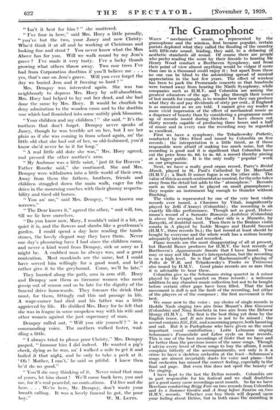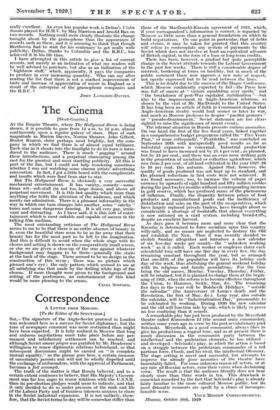The Gramophone-
WHEN " mechanical " music, as represented by the gramophone and the wireless, first became popular, certain
purists deplored what they called the flooding of the country' with fifth-rate sound, leading, they said, to a debasing of aesthetic standards all round. Of course there are people' who prefer reading the score by their fireside to hearing Sir
Henry Wood conduct a Beethoven Symphony, and front their point of view almost anything would be vulgar if more -than one in a thousand could enjoy it' but apart from these no one can be -blind to the astonishing spread of musical
appreciation in the last few years. The effect of wireless has been to pack the Promenade concerts so that hundreds' were turned away from hearing the Ninth Symphony, while companies such as H.M.V. and Columbia are among the greatest educators of the age. To play through their issues of last month for example, is to wonder how they can produce what they do and pay dividends of sixty per cent., if England is as unmusical as we are told. I cannot give my reader g more vivid impression of the effect of mechanical music as a dispenser of beauty than by considering a programme made up of records issued during October. I have chosen out thirty records capable of producing three hours and a half of music and in every case the recording may be regarded as excellent.
- First we have a symphony,- the Tchaikowsky Pathetic; conducted by Otto Fried and issued by Columbia on five records ; the interpretation is a little timid, as if those responsible were afraid of making too much noise, but the recording is good and it is significant that Columbia have cut the price from gs. 6d. to 4s. 6d. a record thereby aiming at a bigger public. It is the only really " popular " work on our programme. Next, we have a really good organ record, Parry's Bridal March, played in St. Paul's Cathedral by Dr. Marchant (H.M.V.) ; a Bach D minor fugue is on the other side. The value of this is as much sentimental as musical, for the echo takes away from the detail but adds to the" atmosphere." Records such as this must not be played on small gramophones ; they require an instrument big enough to thunder without flinching.
The violin is represented by one of the very best violin records ever issued, a Chaconne by Vitali, magnificently played by Jelli d'Aranyi (Columbia) ; the recording is an exactly life-like performance. Though not as good, Huber- mann's record of a Sarasate Romanza Andaluza (Columbia) is above the average, but the other side is a Mazurka, by Zarzycki, of doubtful merit. Then there is the Braluns violin sonata in A played by Isolde Menges and Harold Samuel (H.M.V., three records 9s.) ; the last record at least should be bought by everyone and the whole work has a serious beauty adequately interpreted and recorded.
Piano records are the most disappointing of all at present; but Harold Bauer produces for H.M.V. the best records of Beethoven's Appassionata Sonata that I have heard. You may or may not like Bauer's interpretation, but the recording is on a high level. So is that of Rachmaninoff's playing of Polka de W .R. and Tchaikowsky's Troika en Traineaux also issued by H.M.V. Good piano records are so rare that it is advisable to hear these.
Columbia give us the Schumann string quartet in A minor played by the Capet quartet on three records : a -welcome addition to any chamber music collection but not to be bought before certain other gaps have been filled. That the last movement is dull is not the fault of the recording, but either of the players or of the composer ; the first movement is the best.
We come now to the voice : my choice of single records is Heddle Nash singing two airs from Mozart's Don Giovanni (Columbia) and Nina Koschetz in two airs from the Hebrew liturgy (H.M.V.). The first is the best thing yet done by the English tenor, and 11 mio tesoro is not to be missed ; the second contains Eili, Eili, and a mourning prayer, both haunting and sad. But it is Parlophone who have given us the most important vocal contribution Lotte Lehmann singing Schumann's Frauenliebe und contribution; cycle on four records.
This is one of the best recordings of lieder that we have and far better than the previous issues of the same songs. Though I advise every lover of these songs to buy the album, I must complain bitterly of the accompaniments, not only is it a crime to have a skeleton orchestra at the feast—Sclunnann's songs are almost invariably duets for voice and piano—but that orchestra has missed the correct feeling, especially in the final sad page. But even this does not spoil the beauty of
the singing. •
I have kept to the last the Delius records. Columbia are in part responsible for his festival and we shall doubtless get a good many more recordings next month. So far we have Beecham conducting Brigg Fair on two records from Columbia and In a Summer Garden and A Song before Sunrise on .two H.W.V. records. Whether you buy them will depen4, upon your feeling about Delius, but in both Citiei The recoiting is really excellent. An even less popular work is Delius's Violin Sonata played for H.M.V. by May Harrison and Arnold Bax on two records. Nothing could more clearly illustrate the change brought about by the gramophone than the appearance of records such as these, and it is amusing to think that though Beethoven had to wait for his centenary to get really wide publicity, Delius, thanks to Columbia and the B.B.C., has achieved it in his life time.
I have attempted in this article to give a list of current records, not merely as an indication of what my readers will be well advised to purchase, but also as an indication of the "highbrow stuff," which, apparently, it pays the companies to produce in ever increasing quantity. Who can say after reading the list that there is not a marked improvement of taste and increase of appreciation of music in England as a result of the enterprise of the gramophone companies and the B.B.C. ?
JOHN LANGDON-bAVIES.









































 Previous page
Previous page